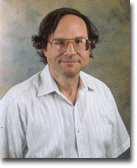| Biography: Dr. Stern studied theoretical physics at Princeton and received an M.D. degree from University of Pennsylvania. Following internship, he was a Staff Fellow in the Laboratory of Technical Development of the NHLBI, where he invented a method to measure tissue microvascular blood flow using laser light scattering. Following an Internal Medicine residency at University of Michigan and Cardiology fellowship at Johns Hopkins, Dr. Stern joined the faculty in Cardiology at Johns Hopkins in 1981. His research on laser light scattering fluctuations in cardiac muscle, in collaboration with the Laboratory of Cardiovascular Science at GRC, led to the discovery that apparently resting heart muscle produces continuous, random asynchronous subcellular waves of contraction, which proved to be due to propagated calcium release from the sarcoplasmic reticulum. This led directly to his present interest in the basic mechanism of cardiac excitation-contraction coupling. His studies on the physiology of excitation-contraction coupling in single cardiac myocytes during extreme hypoxia led to the finding that reoxygenation injury is due to calcium shifts brought about by ionic conditions created during a vulnerable period of complete energy depletion. In parallel with this work, Dr. Stern carried out mathematic modeling of the basic mechanisms of sarcoplasmic reticulum calcium release. Based on this work he proposed, in 1992, the local control hypothesis of excitation contraction coupling, has become the leading theory of this process. In 1996, Dr. Stern joined LCS full time as a member of the Senior Biomedical Research Service. |
| Calcium Microdomain Signaling in Intracellular Communication: The heartbeat is initiated by the release of calcium from stores in the sarcoplasmic reticulum (SR). It is now well established that the trigger for this release is the entry of a much smaller amount of calcium through voltage-controlled L-type calcium channels in the cell membrane. This is the mechanism of calcium-induced calcium release (CICR), which is known to be mediated by ryanodine receptors, which are calcium sensitive calcium channels located in the membrane of the SR. Similar ryanodine receptors are located on intracellular calcium stores in a wide variety of cell types, where their function is not yet understood. |
| The release of SR calcium is a tightly controlled and smoothly graded function of the trigger calcium; this is paradoxical since CICR is an intrinsically self-reinforcing process which might be expected to lead to an all-or-none response. A possible resolution of the paradox is based on the fact that the L-type trigger channels and the SR release channels are known to be localized to opposite sides of the 15 nm dyad junctions between the cell membrane and the SR membrane. This means that the trigger for CICR is not whole cell calcium, but rather the local calcium microdomain generated in the neighborhood of the triggering channel. We have shown mathematically that the interaction between the stochastic gating of individual channels and the fluctuating calcium microdomains which they generate can give rise to smoothly graded and controlled calcium release in the whole cell aggregate, even though individual release events may be nearly all-or-none. This is the local control hypothesis, which implies that whole cell calcium release depends critically on the details of the gating and ion permeation of the trigger and release channels, and on the local geometrical relationship between them. Over the past several years, considerable evidence has accumulated showing that this is the case. We have recently constructed a similar local-control model of the role of CICR in skeletal muscle excitation-contraction coupling. This model successfully explains many paradoxical observations, and leads to the insight that collective behavior of mesoscopic arrays of calcium-coupled release channels, which we term couplons, may be the basic functional unit of EC coupling. |
| In order to test the local control hypothesis more definitively, we hope to develop a model in which the full machinery of excitation-contraction coupling (junctions, ryanodine receptors, L-type calcium channel, auxiliary junctional proteins) is expressed and in which the components and the signals that control their localization can be manipulated genetically. This is the major project of our laboratory at the present time. Since cardiac myocytes are terminally differentiated and non-dividing, they cannot be used directly. In general, cultured cell lines do not form SL/SR junctions even when expressing the channel proteins. Our present approach to the problem is to make use of the well developed technique of gene targeting in mouse embryonic stem (ES) cells, together with in vitro differentiation of ES cells into embryoid bodies which contain beating cardiac myocytes. We have successfully established culture techniques which promote cardiac differentiation in a high percentage of embryoid bodies, and have demonstrated calcium sparks and waves, which are produced by RyR-mediated intracellular calcium release, in cells as early as 7 days of differentiation. These studies will be continued to characterize the biochemistry, ultrastructure and EC coupling physiology of these cells. These baseline studies will define that model and lead to increased understanding of the development of cardiac-type EC coupling. We will then use homologous recombination methods to obtain cardiac myocytes in which the key protein domains responsible for calcium sensing and release, and others (such as the enormous 2 megadalton "foot process" of the ryanodine receptor) whose function is unknown, have been altered. More importantly, we hope to discover the signals which give rise to the organized geometrical structure of the dyad junction, and to alter it in order to test the sensitivity of coupling to geometry which is predicted by the local control theory. A combined approach utilizing ES cell techniques, confocal calcium measurement, patch clamp and mathematical modeling will be used. |
| Since ryanodine receptors are ubiquitous, it is likely that the insights gained from this program will be important for understanding the way in which spatial and temporal localization of intracellular calcium signals leads to their diversity of function in many cell types. |



